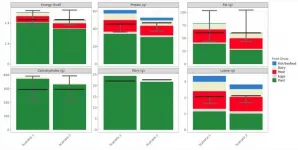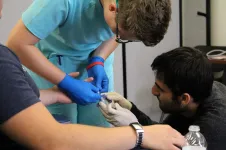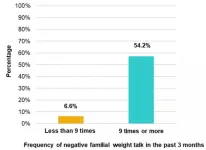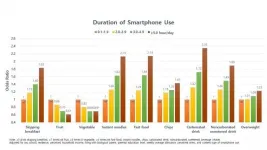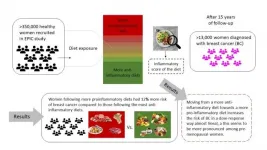Lead halide perovskites -- a horse of a different color
2021-06-07
(Press-News.org) Metal halide perovskites have been under intense investigation over the last decade due to the remarkable rise in their performance in optoelectronic devices such as solar cells or light-emitting diodes. Despite tremendous progress in this field, many fundamental aspects of the photophysics of perovskite materials remain unknown, such as a detailed understanding of their defect physics and charge recombination mechanisms. These are typically studied by measuring the photoluminescence - i.e. the emission of light upon photoexcitation - of the material in both the steady-state and transient regimes. While such measurements are ubiquitous in literature, they do not capture the full range of the photophysical processes that occur in metal halide perovskites and thus represent only a partial picture of their charge carrier dynamics. Moreover, while several theories are commonly applied to interpret these results, their validity and limitations have not been explored, raising concerns regarding the insights they offer.
To tackle this challenging question, a trinational team of researchers from Lund University (Sweden), the Russian Academy of Science (Russia) and the Technical University of Dresden (Germany) have developed a new methodology for the study of lead halide perovskites. This methodology is based on the complete mapping of the photoluminescence quantum yield and decay dynamics in the two-dimensional (2D) space of both fluence and frequency of the excitation light pulse. Such 2D maps not only offer a complete representation of the sample's photophysics, but also allow to examine the validity of theories, by applying a single set of theoretical equations and parameters to the entire data set. "Mapping a perovskite film using our new method is like taking its fingerprints - it provides us with a great deal of information about each individual sample." says Prof. Ivan Scheblykin, a Professor of Chemical Physics at Lund University. "Interestingly, each map resembles the shape of a horse's neck and mane, leading us to fondly refer to them as 'perovskite horses', which are all unique in their own way."
"The wealth of information contained in each 2D map allows us to explore different possible theories that may explain the complex behavior of charge carriers in metal halide perovskites" adds Dr. Pavel Frantsuzov from the Siberian Brunch of the Russian Academy of Science. Indeed, the researchers discovered that the two most commonly applied theories (the so called 'ABC theory' and the Shockley-Read-Hall theory) cannot explain the 2D maps across the entire range of excitation parameters. They propose a more advanced theory that includes additional nonlinear processes to explain the photophysics of metal halide perovskites.
The researchers show that their method has important implications for the development of more efficient perovskite solar cells. Prof. Dr. Yana Vaynzof, Chair for Emerging Electronic Technologies at the Institute for Applied Physics and Photonic Materials and the Center for Advancing Electronics Dresden (cfaed) explains: "By applying the new methodology to perovskite samples with modified interfaces, we were able to quantify their influence on the charge carrier dynamics in the perovskite layer by changing, for example, the density and efficacy of traps. This will allow us to develop interfacial modification procedures that will lead to optimal properties and more efficient photovoltaic devices."
Importantly, the new method is not limited to the study of metal halide perovskites and can be applied to any semiconducting material. "The versatility of our method and the ease with which we can apply it to new material systems is very exciting! We anticipate many new discoveries of fascinating photophysics in novel semiconductors." adds Prof. Scheblykin.
The work was now published in the prestigious journal Nature Communications.
INFORMATION:
Title: Are Shockley-Read-Hall and ABC models valid for lead halide perovskites?
Authors: Alexander Kiligaridis, Pavel Frantsuzov, Aymen Yangui, Sudipta Seth, Jun Li, Qingzhi An, Yana Vaynzof and Ivan G. Scheblykin
Nature Communications 12, Article number: 3329 (2021)
DOI: 10.1038/s41467-021-23275-w
Link: https://www.nature.com/articles/s41467-021-23275-w
Media inquiries:
Prof. Ivan G. Scheblykin
Professor of Chemical Physics, Department of Chemistry, Lund University, Sweden
Tel. +46 46 222 48 48
E-Mail: ivan.scheblykin@chemphys.lu.se
Dr. Pavel Frantsuzov
Head of Theoretical Chemistry Lab
Voevodsky Institute of Chemical Kinetics and Combustion
Siberian Brunch of the Russian Academy of Science
Tel. +7 383 333-2855
E-Mail: pavel.frantsuzov@gmail.com
Prof. Dr. Yana Vaynzof
Chair for Emerging Electronic Technologies at the Institute for Applied Physics and Center for Advancing Electronics Dresden - cfaed at TU Dresden
Tel. +49 351 463-42132
E-Mail: yana.vaynzof@tu-dresden.de
About cfaed
cfaed is a research cluster at TU Dresden (TUD). As an interdisciplinary research center for perspectives of electronics, it is located at the TUD as a central scientific unit, but also integrates nine non-university research institutions in Saxony as well as TU Chemnitz as cooperating institutes. With its vision, the cluster aims to shape the future of electronics and initiate revolutionary new applications, such as electronics that do not require boot time, are capable of THz imaging, or support complex biosensor technology. These innovations make conceivable performance improvements and applications that would not be possible with the continuation of today's silicon chip-based technology. In order to achieve its goals, cfaed combines the thirst for knowledge of the natural sciences with the innovative power of engineering. http://www.cfaed.tu-dresden.de
[Attachments] See images for this press release:

ELSE PRESS RELEASES FROM THIS DATE:
2021-06-07
Rockville, Md. (June 7, 2021) - Healthy habits are particularly important during pregnancy. Four new studies being presented at NUTRITION 2021 LIVE ONLINE look at how supplements, eating habits and physical activity can affect various aspects of health during pregnancy.
Prenatal supplements might influence bacterial composition of breast milk
Breast milk contains a unique mix of bacteria - known as its microbiota - that plays an important role in child health. In a new study, researchers from Purdue University examined whether diet or supplements taken prenatally affected the microbiota of breast milk in 771 mothers participating in the CHILD Cohort Study. The analysis revealed that supplements, but not dietary patterns, were linked with changes in human milk microbiota ...
2021-06-07
Rockville, Maryland (June 7, 2021) -- Only 5% of men and 9% of women are getting the recommended daily amount of dietary fiber, according to a study being presented at NUTRITION 2021 LIVE ONLINE. Insufficient fiber intake is associated with a higher risk of heart disease and diabetes, two of the most common diseases in the U.S.
"These findings should remind people to choose fiber-rich foods like whole grains, fruits and vegetables to reduce their risk for heart disease," said Derek Miketinas, PhD, RD, an assistant professor at Texas Woman's University, the study's ...
2021-06-07
Rockville, Maryland (June 7, 2021) -- Reducing food waste is crucial to our ability to feed the growing human population but will not fully solve the problem alone, according to a new study based on a computational model.
Researchers calculate that the world already produces enough protein and energy to feed 9.7 billion people--the projected population as of 2050--if food waste were cut in half. However, projections indicate global food production will still fall short in terms of micronutrients that our bodies need to stay healthy, including calcium, iron, vitamin E and others.
"Reducing food waste would give us enough protein and food energy to feed the 2050 population today--but not enough of the essential ...
2021-06-07
Rockville, Maryland (June 7, 2021) -- According to a new study, people who eat faster or take larger bites are more likely to eat more at a meal. The research, which is being presented at NUTRITION 2021 LIVE ONLINE, provides new insight into the factors that might contribute to overeating.
The study also adds more evidence that people eat more when given larger portions. The researchers found that study participants ate, on average, 43% more when the portion size of a meal was increased by 75%.
"Although studies have consistently found that people eat more when they are served larger portions, less is known about why this happens or why some people ...
2021-06-07
Rockville, Md. (June 7, 2021) - Superfoods like turmeric and honey have long been recognized for their ability to promote health and wellness. New studies being presented at END ...
2021-06-07
Rockville, Maryland (June 7, 2021) -- What we eat during childhood can affect the health of individuals--and populations--for years to come. As rates of childhood obesity continue to rise, five studies being presented at NUTRITION 2021 LIVE ONLINE bring new insights into the diets of children and teens around the world.
Families report substantial child weight gain during COVID-19
Researchers at Virginia Commonwealth University surveyed over 400 parents about their children's weight and eating habits before the COVID-19 pandemic and at two points during ...
2021-06-07
Rockville, Maryland (June 7, 2021) -- Even moderate smartphone use may influence teens' diet and weight, according to a new study of more than 53,000 Korean adolescents. Teens who used a smartphone for more than 2 hours per day were significantly more likely to eat more junk food and fewer fruits and vegetables than those spending less time on their phone. Teens spending more than 3 hours per day on a smartphone were significantly more likely to be overweight or obese.
"While earlier studies have shown that TV watching is an important factor that increases the risk of obesity in children and adolescents, little is known about the effects of modern screen time such as smartphone use on diet and obesity," said Hannah Oh, ScD, assistant professor at ...
2021-06-07
Rockville, Maryland (June 7, 2021) -- Studies being presented at END ...
2021-06-07
Rockville, Maryland (June 7, 2021) -- A new study of more than 350,000 women found that women with diets incorporating more foods that increase inflammation in the body had a 12% increase in their risk of breast cancer compared to women who consume more anti-inflammatory diets. The new findings are being presented at NUTRITION 2021 LIVE ONLINE.
The study authors found that moving from a more anti-inflammatory diet toward one that increases inflammation upped breast cancer risk in an almost linear manner. Foods that increase inflammation include red and processed meat; high-fat foods such as butter, margarines and frying fats; and ...
2021-06-07
Rockville, Maryland (June 7, 2021) -- What did Americans eat during the Great Recession? A new study suggests dietary quality plummeted along with the economy.
According to the study, adults overall ate more refined grains and solid fats and children increased their intake of added sugar during the recession. The impacts of the downturn were especially pronounced in food-insecure households, where individuals significantly reduced their intake of protein and dark green vegetables while increasing total sugars.
"Overall, we found that the Great Recession had a negative impact on dietary ...
LAST 30 PRESS RELEASES:
[Press-News.org] Lead halide perovskites -- a horse of a different color



